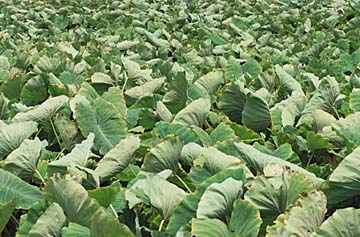


The staple is thriving thanks
By Alisa LaVelle
to a Haleiwa farmer
and others
Star-BulletinIt takes hard work in the sun to grow taro. There is bending, pulling and cleaning. Then there is cutting, planting and digging.
But for at least one taro farmer, times have improved.
"Now we got umbrellas and sit," said Ernest Tottori, president of Honolulu Poi Company (HPC Foods Ltd). "It's nice and cool. And romantic."

Tottori uses his farm near Haleiwa to research better cultivation techniques."We had to cut down the stoop labor. Make it easier for the younger generation," he said.
We took the fun out of farming, he said, then laughed. What he's tried to do is cut down on the back strain and perspiration involved in taro farming through better equipment and cultivation methods.
But it's still hard work.
Tottori's HPC Foods Ltd. is the top-producing taro company in the state.

An estimated 6 million pounds of poi was produced last year in Hawaii. That's 9 percent more than the year before, according to the Hawaii Department of Agriculture."The industry is slowly reviving," said Eric Enomoto, HPC Foods Ltd. treasurer and controller. In 1946, Hawaii produced more than 14 million pounds.
University of Hawaii taro specialist John Hollyer said the resurgence in taro farming over the past five years has to do partly with the revival of interest among the Hawaiian community.
Hollyer said taro farming is labor intensive and takes commitment.
"They (taro farmers) have my respect," he said.

Taro is No. 14 on the list of most-consumed vegetables in the world, according to the book "Taro Mauka to Makai." Of more than 100 varieties, Hawaii grows only one genera of taro, colocasia.Out of this one genera come the 50 varieties used to produce poi in Hawaii. Varieties differ according to climate and location. This accounts for the different taste, and preferences based on location.
Someone in Kona might be used to upland taro that makes a brown poi, but a Honolulu person is used to purple poi, Hollyer said. Variety, production and cooking methods vary company to company, location to location.

"All this is incorporated into the taste," he said.Meanwhile, Tottori continues to look for ways to improve taro production. He is the third generation to own the taro-producing company, and he hopes to pass it to the next generation.
"I'm working for the fourth generation," Tottori said. "And trying to assure that poi going be in Hawaii forever."

